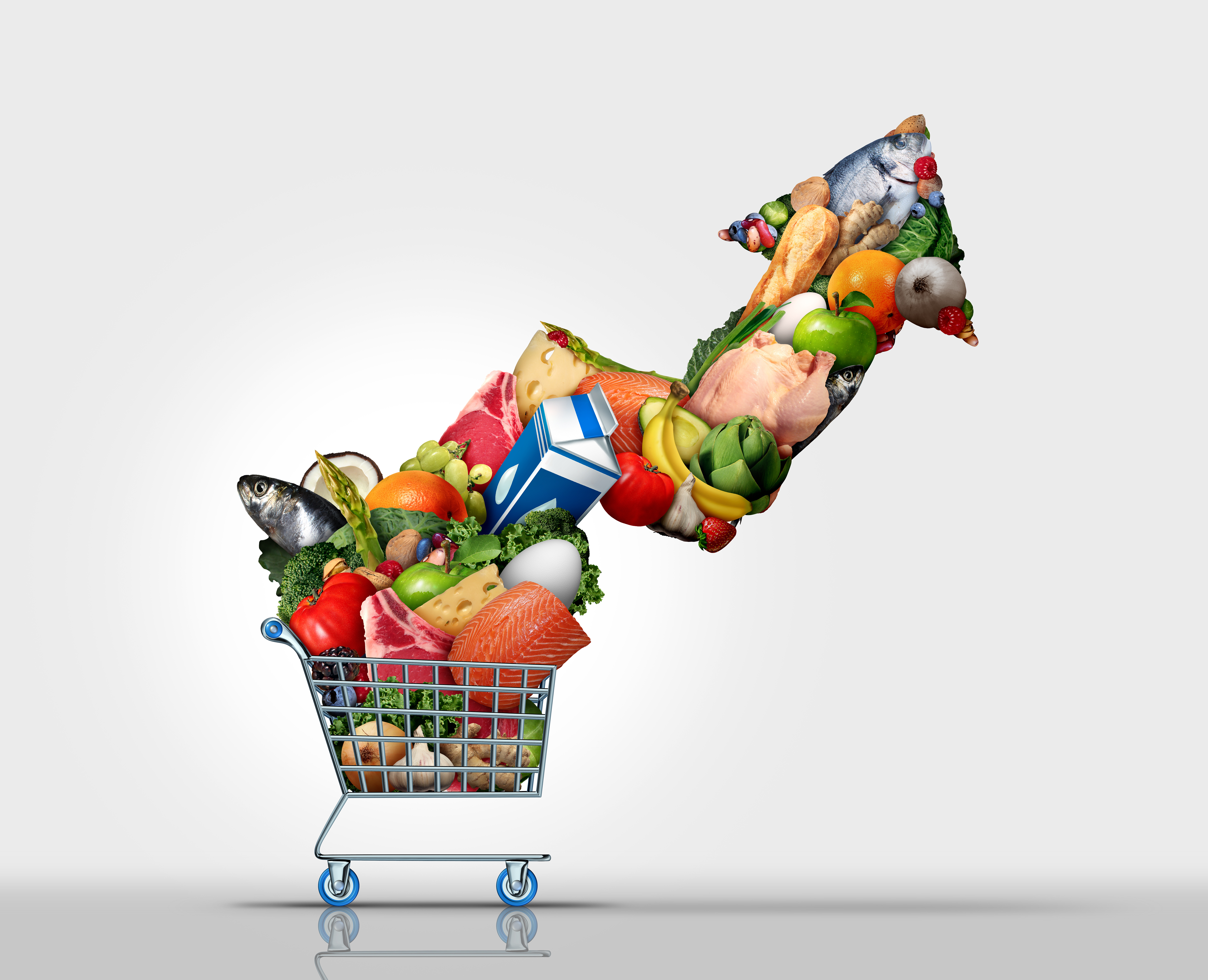A Look at Continued Inflation and Its Impact on a Group of Key Industries

In this article, Hilco experts from across our Valuation Services team discuss how the ongoing inflationary environment is impacting a broad range of industries from a cost, pricing and operational perspective.
Inflation was relatively non-existent for much of the last business cycle. So much so, that business leaders across most every industry and sector could be heard lamenting its absence and the lack of opportunity that existed to increase prices as a means of allowing for increased wages and improved corporate profitability. According to the Federal Open Market Committee at the time, a 2% inflation rate was deemed to be healthy for the economy. Such a predictable, manageable level meant that a healthy tug-of-war between supply and demand could exist and promote economic growth. Things, of course, would not work out quite that simply. Enter the global pandemic and the ensuing chaos.
AUTOMOTIVE
The arrival of COVID-19 in the first quarter of 2020 cast the once vaunted supply chain of the automotive industry A Look at Continued Inflation and Its Impact on a Group of Key Industries By the Experts at Hilco Valuation Services SMARTER PERSPECTIVE: MULTIPLE INDUSTRIES into disarray. While the sentence was quick, restitution has been painfully slow. The industry has struggled to restore any semblance of balance between supply and demand. Material managers refer to it as “whack-a-mole,” the children’s game where every time one mole is chased underground, another pops up elsewhere. Chasing parts shortages has been a non-stop activity for the last 12 months. Just as soon as supply is restored on one part, the supply of another part is depleted.

As of yet, there has been no “vaccine” developed for the ailments of the supply chain and material managers will tell you that there is no category of parts that has developed an immunity. This includes the labor force. Unemployment levels had sunk below 4% prior to the pandemic and they near those levels again. Nobody is complaining about the lack of inflation anymore. The price for new and used cars have increased precipitously in the past 18 months. Retailers and distributors of parts for light-duty vehicles are reporting 3% – 5% inflation and 4% – 6% on parts for heavy-duty vehicles. Most materials managers are confident law and order will eventually be restored to the supply chain. Most human resource managers are not as confident and worry that the solution to the labor shortage is much longer-term. For now, retailers and distributors have been able to recover inflation by passing it on to the consumer. The longer that shortages exist, however, the more difficult it will be to maintain profitability.

FOOD
According to the U.S. Department of Agriculture Economics Research Service, the 20-year historical average for food inflation is 2.4 percent per year. In 2020, annual food prices increased 3.4% and in 2021 they rose by 3.9%. Segments experiencing substantial increases over the last year include: Beef and Veal (+18.6%); Pork (+15.1%); Poultry (+9.5%); Fish and Seafood (+8.4%); Eggs (+11.1%); Fats and Oils (+8.8%); and Fresh Fruit (+7.9%).
Anhydrous ammonia, which is the primary source of nitrogen fertilizer, increased substantially in 2021 based on reporting from Data Transmission Network. While the 5-year average price was around $500 per ton, prices increased to all-time highs of $1493 per ton in January 2021. According to Reuters, prices are at record highs “due to the soaring cost of the natural gas used to produce them, and severe storms that have disrupted production.” The cost of fertilizer is a crucial input cost for corn and wheat prices. The U.S. is the largest producer of corn in the world, and approximately half of U.S. corn production is actually used for animal feedstock. As a result, large price increases escalate costs dramatically and have wide-ranging implications for food supply. Case in point, because these increases in fertilizer costs also impact which crops farmers plant, this can result in farmers planting less fertilizer-rich crops such as soybeans. Additionally, in recent weeks, wheat prices have skyrocketed as well. Russia and Ukraine combined account for nearly one-third of the world’s wheat and barley exports. The products they supply are made into bread, noodles and animal feed across the globe.
From a labor perspective, costs have increased as well in many areas and the pandemic has driven many workers away from restaurants, most of which are currently experiencing staffing shortages as a result. Demand for warehouse workers within the food industry also remains high, although, admittedly, under the most normal of circumstances it is rare for us to visit any warehouse and see it fully staffed. As widely reported, gas prices have risen even further in response into current world developments and the cost of importing product from overseas continues to run high, as food companies require added working capital to pay for more expensive containers and account for inventory stuck in port due to supply chain challenges. Even though these and other costs are rising, some food producers with high demand have been able to pass them on to customers and improve profitability, even with many plants at only around 80% of capacity. On the retail side, food chains such as Starbucks and McDonald’s are also taking the path of increasing customer prices to account for cost increases. Foodservice is still recovering, but is much improved from 2020.
We expect to see increasing fertilizer, transportation, and labor costs continue to drive up prices in 2022 for meats, dairy, fruits/vegetables, and other food categories.
HOME FURNISHINGS
The home furnishings industry has been experiencing notable inflationary pressure stemming from a few primary factors, including insufficient manufacturing capacity, increased freight and raw material costs. Employers, struggling with worker shortages, have had to raise wages as an incentive to keep existing employees and attract potential new candidates. With smaller workforces, production capacity is reduced. Freight container shortages have led to a substantial increase in container prices, forcing retailers, wholesalers, and manufacturers to “bite the bullet” and either pay the increase or jeopardize future sales and customer relationships based on a lack of inventory available for sale. The freight issues, however, do not end with these costs. Once a container finally does arrive at its destination port, further delays are occurring with offloading the vessel (staff shortages) and getting the containers on trucks to be delivered (driver shortages). In an effort to offset these ocean freight delays, some companies have resorted to air freight, which, of course, comes at a hefty price. In terms of raw materials, there has been continuous increases in the cost of lumber, metal, foam and cotton, the primary base materials used in home furnishings (i.e., furniture, décor, and towels).
The factors above are, in turn, leading to increased product costs. In most cases, these are being passed on to the consumer, although some retailers, wholesalers, and manufacturers are working with suppliers to split the higher costs, so these increases do not have to be borne by their customers and consumers. Prices are going to continue to escalate until demand is brought back in line with supply, either through slower demand growth, faster supply growth, or a combination of the two.

Home furnishings retailers continue to suffer from a lack of inventory and long lead times.
LUMBER/PAPER
Market prices for softwood lumber have been on a wild ride since COVID struck the U.S. back in early 2020. During the initial months of the pandemic, when new home construction was deemed an essential activity, demand for lumber remained robust. That demand only increased as people began to remodel their homes and looked for larger residences amid the work from home environment and the desire to socially distance. Although slowing slightly over the past six months, the housing market remains robust and demand for lumber continues to run high. Supply of lumber, however, has remained relatively limited over the last couple of years with companies along the supply chain struggling to maintain enough staff amid the initial COVID wave and subsequent delta and omicron variants. Market prices for softwood lumber normally range between $250 and $450 per thousand board foot (MBF). Since June 2020, however, the floor for softwood lumber has been $450 per MBF and prices have reached as high $1600 per MBF in June 2021. Recent lumber prices hit approximately $1200 per MBF, nearly triple the level that would have been considered strong only a few years ago.
Sawmills are taking the overwhelming majority of the lumber price increases to the bottom line as the increase in the price of logs has remained relatively muted. The largest beneficiaries have been sawmills processing pine in the southern part of the U.S. After years of overplanting pine plantations, landowners are not able to gain advantage of the highest lumber prices on record. While prices for logs have increased more in other parts of North America, namely Canada, sawmills in those regions are still enjoying record profit margins.
METALS
Steel
Market prices for most steel increased rapidly in 2021 as the effects of the COVID-19 Pandemic waned. Prices peaked in the fourth quarter of 2021 and have since decreased, but remain significantly above pre-Pandemic levels. While most steel product pricing had trended downward or was flat prior to the start of the Pandemic, its arrival disrupted demand for auto and other industrial goods, and in turn basic steel products. Uncertain of demand, producers and distributors reduced their inventories throughout the supply chain and steel mills significantly reduced output.
As economies around the world expanded in the later part of 2020, demand increased while the depleted supply chain and fierce competition for resources resulted in increased market prices. Producers that had historically been exporters were now selling more within their own borders. Meanwhile, the residual effects of the Trump-era tariffs, longer shipping lead times, and significantly higher export cargo prices all combined to discourage imports into the U.S. These decreased imports along with higher import prices, allowed domestic producers to increase both their output and their prices.
While it is likely that steel market prices will continue to decrease, they are likely to ultimately stabilize well above pre-pandemic levels.
While the economy was expanding, consolidation of the steel industry continued. Cleveland Cliffs, which historically operated as an iron ore mining company, purchased AK Steel and ArcelorMittal’s U.S. operations, thereby combining two of the country’s largest steel producers. Other consolidation occurred, including U.S. Steel’s purchase of Big River Steel, which served to further reduce price competition among domestic producers. Not surprisingly, costs associated with steel production have increased during this period. Iron ore, metallurgical coal, energy, labor and other costs all increased in 2021 and remain at higher levels. While it is likely that steel market prices will continue to decrease, they are likely to ultimately stabilize well above prepandemic levels.
Aluminum
Like steel, aluminum output also decreased during the Pandemic and then demand outpaced supply as the world economy expanded. China, the world’s largest producer, decreased production to control pollution and Co2 levels, further decreasing world supply. It is also worth noting that in 2021, the three largest exporters of aluminum were Canada, Russia and the United Arab Emirates. Russia’s current invasion into the Ukraine could bring embargos on Russian aluminum, further escalating aluminum pricing.
PLASTICS/CHEMICALS
CEO Thomas E. Gottwald of NewMarket Corporation (NEU) stated in a letter reporting NEU’s 2021 operating results – “Throughout the year, we have continued to see our operating margins decline mainly due to the prolonged period of escalating raw material costs. While we have made some progress in adjusting our selling prices to offset the effects of the higher costs, we have not been able to adjust sufficiently to offset the cost increases. We continue to see a lag between when price increases go into effect and when we begin to see margin recovery. This lag will continue until we see a period where raw material prices stabilize. We have also seen significant increases in many elements of our operating costs such as utilities, logistics, insurance, and third-party manufacturing services. In addition, the worldwide supply chain disruptions continue to negatively impact our business. Margin recovery and cost control will be priorities throughout 2022 so that we will return to our historical profit margin range.
We will also be working hard to resolve continuing supply chain issues to meet our customers’ growing needs, and we expect to see improvement in the supply chain and in our performance as the year unfolds.”
It is safe to say that, at the present time, virtually any company within the chemical industry could make a similar statement regarding the current operating environment and inflation. While NEU primarily manufactures additives and lubricants, regardless of what position a company occupies in the chemical industry supply chain right now, it is dealing with significant inflationary pressure from increased prices for raw materials, utilities, insurance, and most operating costs. Shipping delays, product availability, and labor shortages have all added to the inflationary pressures. As a result, most companies have increased prices, many quite significantly. While all companies have had inflationary pressure on their margins, the individual company and its market position dictated whether margins expanded or declined. That said, reduced margins driven by inflation have not been at all uncommon as of late. Many CEOs and experts are currently forecasting for inflation to continue through at least the first half of 2022, with continued pressure being applied by supply and labor shortages. Most chemical companies will continue to raise prices, but the general sentiment in the market is to continue to expect more of the same with high inflation and continued challenges caused by logistics, supply,
SEAFOOD
Seafood pricing like all other products has experienced added costs due to the global supply pressures. This has of course resulted in higher product landing costs. The impacts to product margins vary depending on customer/supplier Frozen seafood dollar sales in February of this year experienced a 9.4% percent drop from the same period in 2021, according to new data released by IRI. While it is likely that steel market prices will continue to decrease, they are likely to ultimately stabilize well above pre-pandemic levels. Hilco Global is the Asset Smarter partner to businesses across multiple industries. arrangements. Those maintaining fixed contracts with larger retailers for private label products are seeing negative product margin impacts in the short term as many are unable to pass along 100% of pricing increases to clients. Suppliers who sell based on prevailing market pricing are able to flex pricing accordingly, which has resulted in margin fluctuations based largely on supply/demand equilibrium metrics as opposed to the supply chain inflationary pressures.
TIRES
The pandemic took the air out of the tire industry in 2020. Production by U.S.-based tire makers fell by doubledigits in all key categories, reflecting the weeks and even months of suspended manufacturing at most U.S. tire plants during March, April, and May. For passenger tires, production was at its lowest output level since 1955. During 2021, manufacturers and importers announced a dizzying number of price increases. Their stated rationale is largely predicated on the fact that about two-thirds of their raw materials costs are directly influenced by oil prices, with natural rubber, butadiene, carbon black, and synthetic prices continuing to rise steadily. Given Russia’s invasion of Ukraine and its dramatic impact on oil prices in recent weeks, this is likely to be a continued concern. Well documented port congestion, shipping delays, increased freighter demand, etc. contributed to 40’ container costs for imported tires increasing by over $10,000 over previous norms.
Drivers have always heard that tires need to be properly inflated, but based on these and other factors, the industry may be taking pricing to a whole new level of over-inflated. Leading manufacturer, Michelin North America Inc. just announced their sixth price increase in about a year, citing “market dynamics.” Competitors also raised prices on passenger and light truck (PLT) as well as commercial tires numerous times over the same timeframe.

Increased demand for consumer products and supply chain disruptions, including the previously referenced port congestion and container shortages, has led to inflationary cost pressures.
Gross margins have tended to improve as higher production volumes lower per-unit fixed costs. Similarly at the wholesale and retail levels, the sale of tires purchased ahead of price increases, contributed to higher margins. The future remains a bit uncertain, with resistance building against price increases as many buyers look for lower cost options for their vehicles. Additionally, while many in the supply chain have been able to sell popular sizes and brands, we believe it is possible that slower turning units comprise a larger percentage of actual tires in stock.
CONCLUSIONS
Based upon the thousands of valuations that we have performed over the past few years, Hilco Valuation Services has observed inflation impact numerous industries and companies in varying ways; some more than others. As illustrated in the sampling of industries presented here, price increases have been driven largely by increased raw material prices, labor and transportation costs. Concurrently, demand has been spurred by government stimulus payments, increased paychecks and limited supplies resulting from pandemic-driven production declines Find Additional Smarter Perspectives at hilcoglobal.com and supply chain issues. While companies in some spaces have been able to successfully pass along price increases to customers, others have been unable to do so. Smaller companies have been most impacted overall, as they often just don’t have the size, clout, or capital to circumvent these types of challenges. We have seen these many variables, in combination, impact companies’ inventories in both positive and negative ways when being considered as collateral for asset-based loans. As a result, this has increased the frequency of many of the valuations we perform.
In the current inflationary market, we advise lenders to closely monitor sales in relationship to inventory levels. In our experience, declining sales with flat or increasing inventory levels is often an indication that on-hand inventory is not resonating with customers, which in turn then runs the risk of becoming aged or obsolete. Lenders that are advancing on inventory where there is a freight component included, or built into the cost, should be particularly careful that a borrower’s balance does not get too close to the limit, as a reduction in freight costs could lead to lower inventory levels and an over-advanced position. We also advise lenders to consider reserving for landing costs (freight and duty) and to monitor product margins to gauge the impact of increasing costs and how the associated increase in selling prices are accepted by the customer/end user.
Industry experts from across Hilco Global’s Valuation Services team contributed to this article, including:
- Keith Spacapan (Auto)
- Patrick Jensen (Food)
- Matt Perry (Home Furnishings)
- Jesse Marzouk (Lumber/Paper)
- Michael Sullivan (Metals)
- Kevin Duffy (Plastics/ Chemicals)
- Dean Hogencamp (Seafood)
- Greg Baldor (Tires)
For more information, contact Ed Zimmerlin, EVP- Hilco Valuation Services at
ezimmerlin@hilcoglobal.com or
847.313.4720.











